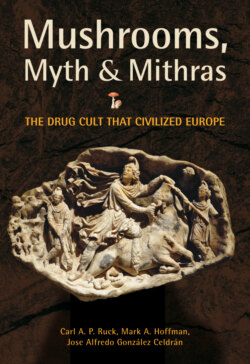Читать книгу Mushrooms, Myth and Mithras - Carl Ruck - Страница 18
The Herdsmen Attendants
ОглавлениеNot unlike the Christian nativity scene, shepherds witnessed the miraculous birth of Mithras, the enigmatic Cautes and Cautopates, who like him wear red caps. The caps alone sometimes represent them, like the twin Dioskouroi, with whom they sometimes are identified.
The Dioskouroi (Dioscuri) were the twin sons of Zeus from his affair with Leda. He seduced her while he was in the form of a swan, and the result was an egg from which they hatched, each maintaining half the shell as their distinctive Phrygian red caps.60 One was mortal and the other immortal, but they shared their fate, alternating between life and death on successive days.
Each of the attendants of Mithras usually carries at least one torch, and they indicate the two directions of the light, or the similar alternation of life and death expressed in the Dioskouroi. They are similar to the two thieves crucified with Christ, one destined for salvation, the other for descent into the underworld.61 In medieval tradition they become the wise and foolish virgins, the former holding their lamps upright, the others with lamps unlit and upside down.
Cautes, apparently representing the rising sun, points his torch upwards, sometimes with the cock that heralds the dawn, the bird in Greek called “Persian,” at his feet, while Cautopates inverts his torch for the setting of the sun; or perhaps they represent the solar equinoxal phases. The mushroom that ascends toward the Empyrean had its origin from the fall of light from the heavens. Cautes is associated with the head of the bull and stands in front of it, while Cautopates is its tail end and stands behind, often holding it in his hand.
